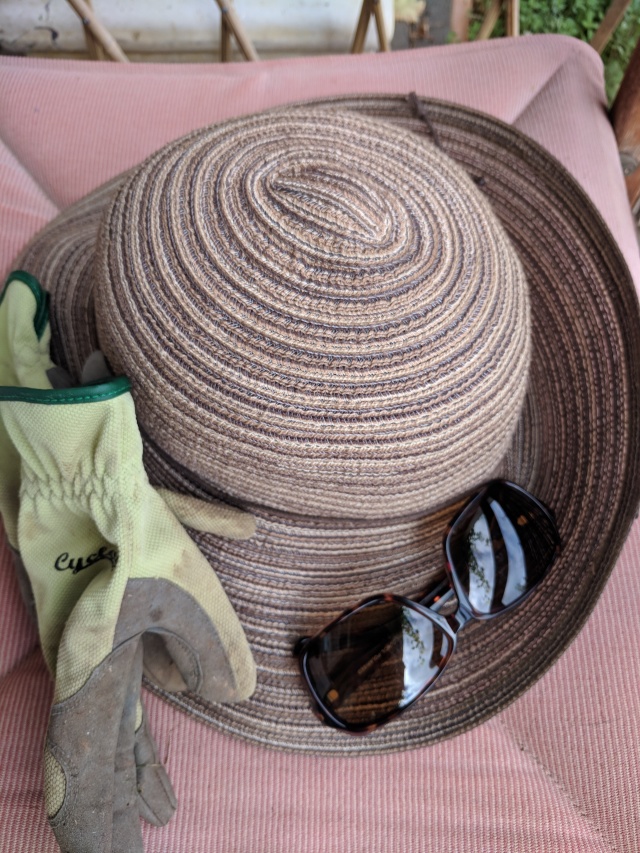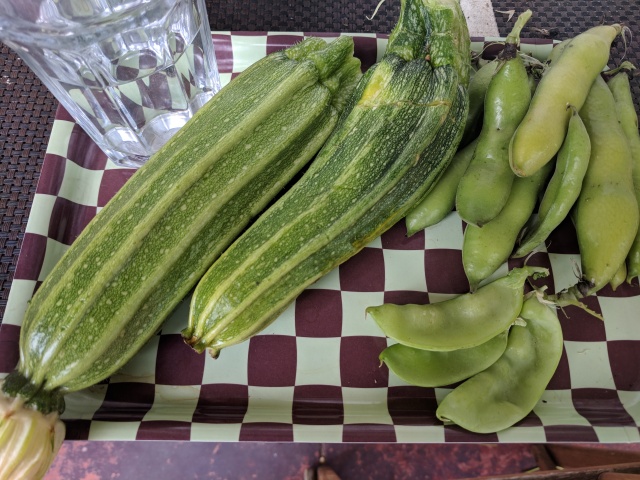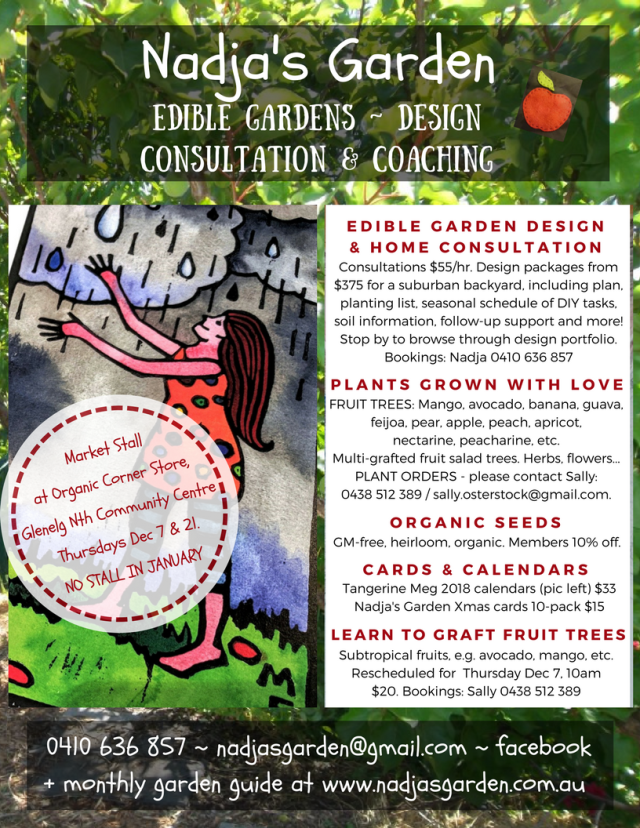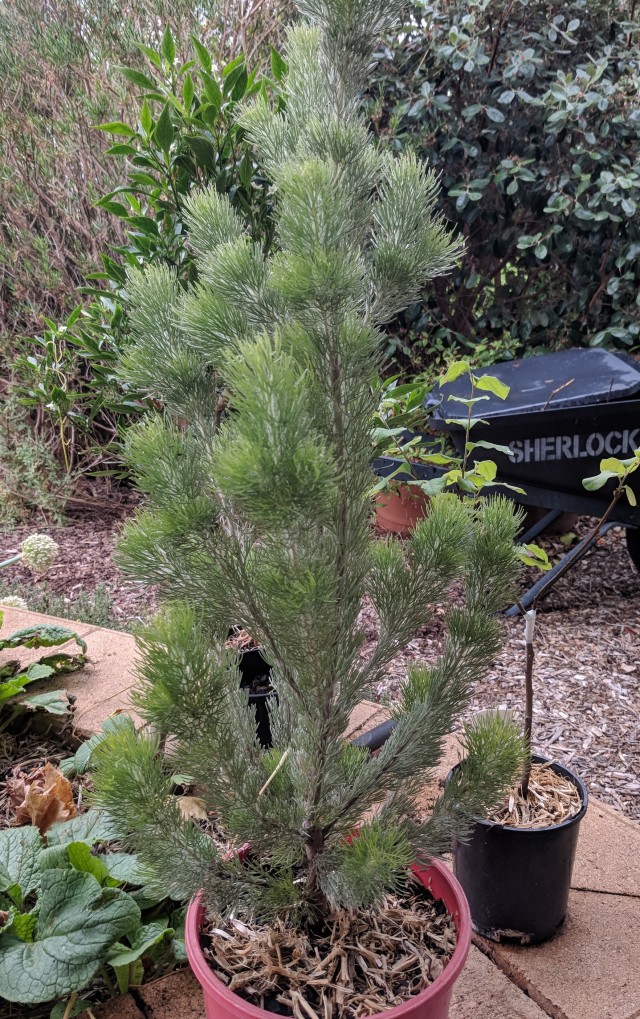It’s been a busy couple of days in the garden, clearing out, rearranging and replanting a couple of vegetable beds, and planting new fruit trees, while the weather is mild enough for plants to settle in without getting either sunburnt or blown over. Weather over the next few days looks good for planting, with extra care needed next week as the heat builds up again.

If the plants need shade, water and protection, so do I.
At this time of the year, the garden often gets squeezed between (1) crazy busy times, (2) tidying up for Christmas and New Year gatherings and (3) intense heat trying to kill it all off! So everything I said last month about shade, water, mulch and trying to find rest and sanity still stands.
Among the plants being cleared out this week were old spring onions, rocket and sweet peas, in varying stages of setting seed – a perfect opportunity to bundle the seeds up for saving and sharing.
It was mostly overcast, but the bees were hard at work. The Greek basil is a year-round favourite of theirs, and although I rarely eat it (the flavour being so overpowering) I keep it at the western end of a vegetable bed for the afternoon shade and windbreak it gives the vegetables – as well as my fear of a bee mutiny if I should ever remove it.
The last of the snowpeas and broad beans have come out of the veg bed, while the Romanesco zucchini keeps on keeping on just as reliably as my son’s dislike of zucchini. So it disappears, grated, into cheesy vegetable fritters, bolognese sauce, etc. This bed also had plenty of mustard growing over winter, deterring root knot nematodes to prepare the soil for the tomatoes which have just gone in.

In preparation for the heat ahead, I’ve reinstated the curved pieces of electrical conduit that extend the grapevines over the veg beds for increased shade. This time I’ve also relocated some of my favourite strong mesh to make vertical growing space for pumpkins, cucumbers and beans.
Here’s a few cooling suggestions:
- For chooks and pets, keep old milk bottles, refill them with water and freeze. Then put these ‘freezer bricks’ into their water container to keep it cool all day.
- Check whether potted plants are drying out and overheating in their pots. They might need to be potted up into something bigger, lighter coloured, shifted into a shadier position (especially afternoon shade), placed on a saucer to retain more water, or watered more often.
- If a potted plant is getting too hot but hasn’t yet grown enough roots to fill the pot it’s in, you can double-pot it to keep the roots insulated. Select a large, light-coloured pot and place a layer of mulch over the base. Stand the smaller pot inside and fill the gap between the two with more mulch. Remember to keep an eye on those roots and if they start to venture out past the inner pot, it’s time for re-potting. Also be sure to water the inner pot, not the outer one.
- The double-potting strategy is also useful to add a bit of weight at the base of plants that are top-heavy, such as my slow-growing frangipanis. These are in plastic pots that stand inside massive concrete planter boxes, with woody mulch in between the inner and outer pots to keep the roots comfortable.
- Water early in the morning before the sun hits the leaves. Slow drip irrigation is most effective, but if you are hand watering, aim for the soil, using a gentle shower spray, not a gushing torrent. Plants can take up the water more efficiently when they are cool, when the water isn’t evaporating the moment it hits the ground, and when leaves haven’t started to wilt. During the day they will release moisture from their leaves, functioning as evaporative cooling.
What to sow/plant this month…
(* = preferably sow seed direct in garden, others are fine as seedlings.)
Subtropical fruit trees and vines while the soil still has good moisture from this week’s rain – but protect them well from wind and sunburn, and keep up the water.
Veg/herbs: Basil, beans (bush and climbing)*, beetroot, Brussels sprouts, cabbage, capsicum and chilli (preferably advanced seedlings now, as these need a long summer to be productive), carrot*, cauliflower, chives, corn* (with good soil and plenty of water), cucumbers*, eggplant (see note for capsicum), squash*, lettuce (preferably semi-shaded), mint (shaded and damp), melons*, parsley, parsnip, seed potatoes, pumpkins*, radish, rocket, silverbeet (soak the seeds for better germination), spring onions, tomato, zucchini*
Tip cuttings from herbs and perennials strike readily now, but need to be kept reliably moist while developing their roots. Filtered light and a sheltered position are best at first. If you’re going away over the warmer months, perhaps wait and take hardwood cuttings in autumn for a slower approach to propagation over winter.
Position new seeds and seedlings as close as possible to dripper outlets, and offer supplementary hand watering to ensure even moisture until they have settled in or grown a few sets of leaves.
Nadja’s Garden over summer… two market stalls in December, then a break in January:

Sally’s subtropical fruit tree grafting… and last call for pet portraits for this year:
Nadja and Sally wish you a very happy Christmas and a green new year.

Woolly bush (Adenanthos sericeus) – a great native Christmas tree.



